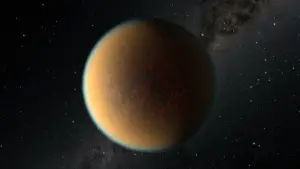Key Takeaways:
- Hubble Space Telescope observations suggest an exoplanet, GJ 1132 b, may have regenerated its own secondary atmosphere after losing its original one.
- The planet orbits a red dwarf star closely, experiencing significant stellar radiation, which possibly led to the creation of its new atmosphere.
- This discovery challenges previous assumptions about highly irradiated planets losing their atmospheres, revealing the potential for atmospheric regeneration.
- Scientists suspect the atmosphere on GJ 1132 b is a result of volcanic activity, with gases seeping out of molten rock, creating a secondary atmosphere rich in hydrogen, hydrogen cyanide, methane, and haze.
In a groundbreaking discovery facilitated by the Hubble Space Telescope, scientists have unveiled a remarkable phenomenon on an alien world, challenging conventional assumptions about planetary atmospheres. The celestial body under scrutiny, GJ 1132 b, situated about 41 light-years away from Earth, has piqued astronomers’ interest due to its potential regeneration of an atmosphere.
Initial observations of GJ 1132 b led scientists to believe that the exoplanet had likely lost its original atmosphere, a common fate for planets subjected to intense stellar radiation. However, a reexamination of Hubble data gathered in 2017 sparked a revelation: the presence of a newly formed secondary atmosphere, a startling development that defied earlier predictions.
Raissa Estrela, a co-author of the study and an exoplanet scientist at NASA’s Jet Propulsion Laboratory, expressed enthusiasm about this unexpected discovery. The resurgence of an atmosphere on a planet previously thought to have lost it challenges preconceived notions about highly irradiated worlds, suggesting a potential for self-regeneration.

Maintaining an atmosphere proves to be a complex feat in the cosmic arena. Earth’s atmosphere owes its stability to factors like the planet’s magnetic field, a luxury not afforded to other celestial bodies. Mars, for instance, lost the majority of its atmosphere eons ago following the demise of its global magnetic shield.
Similar scenarios unfold in the realm of exoplanets, where atmospheric loss can transform gas-rich worlds into barren entities, altering their composition drastically. Mark Swain, the lead author of the research and an exoplanet scientist at JPL, pondered the intriguing possibility: how many terrestrial planets begin their existence as something entirely different?
GJ 1132 b appears to have undergone a unique evolution. After shedding its initial hydrogen- and helium-dominated atmosphere, it transitioned into a desolate world. However, recent Hubble observations hint at an unexpected twist in its narrative: the presence of a novel atmosphere comprised of hydrogen, hydrogen cyanide, methane, and haze, potentially resembling Earth’s atmospheric conditions.

The planet’s close proximity to its host star plays a pivotal role in this transformation. Orbiting its star in such proximity that it always presents the same face, akin to the moon’s orbit around Earth, GJ 1132 b experiences substantial heating, leading scientists to speculate about its volcanic activity.
The peculiar atmospheric composition likely arises from gases emanating from molten rock on the planet’s surface. Scientists envision a molten world encased in a fragile crust, fissured by the gravitational pull of its star, enabling gas to seep out and form this secondary atmosphere.
NASA’s James Webb Space Telescope, slated to offer unprecedented insights. By employing infrared light, this cutting-edge instrument aims to scrutinize GJ 1132 b’s surface, potentially revealing telltale signs of geologic activity such as magma pools or volcanic eruptions.
The findings, detailed in a forthcoming study accepted by The Astronomical Journal and available for preview on arXiv.org, herald a new frontier in exoplanetary studies. GJ 1132 b stands as a testament to the unpredictability of celestial bodies, challenging astronomers to reassess established notions about planetary evolution and the resilience of atmospheres in the cosmic crucible.


